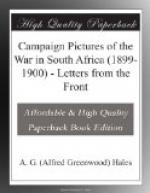WITH THE AUSTRALIANS.
Belmont.
Australia has had her first taste of war, not a very great or very important performance, but we have buried our dead, and that at least binds us more closely to the Motherland than ever before. The Queenslanders, the wild riders, and the bushmen of the north-eastern portion of the continent have been the first to pay their tribute to nationhood with the life blood of her sons, two of whom—Victor James and McLeod—were buried by their comrades on the scene of action a couple of days ago, whilst half a dozen others, including Lieutenant Aide, fell more or less seriously wounded. The story of the fight is simply told; there is no necessity for any wild vapouring in regard to Australian courage, no need for hysterical praise. Our fellows simply did what they were told to do in a quiet and workmanlike manner, just as we who know them expected that they would; we are all proud of them, and doubly proud that the men in the fight with them were our cousins from Canada.
The most noteworthy fact about the engagement is to be gleaned by noting that the Australians adopted Boer tactics, and so escaped the slaughter that has so often fallen to the lot of the British troops when attacking similar positions. Before describing the fight it may be as well to give some slight idea of the disposition of the opposing forces. Our troops held the railway line all the way from Cape Town to Modder River. At given distances, or at points of strategic importance, strong bodies of men are posted to keep the Boers from raiding, or from interfering with the railway or telegraph lines. Such a force, consisting of Munster Fusiliers, two guns of R.H. Artillery, the Canadians, and the Queenslanders, were posted at Belmont under Colonel Pilcher. The enemy had no fixed camping ground. Mounted on hardy Basuto ponies, carrying no provisions but a few mealies and a little biltong, armed only with rifles, they sweep incessantly from place to place, and are an everlasting source of annoyance to us. At one moment they may be hovering in the kopjes around us at Enslin, waiting to get a chance to sneak into the kopjes that immediately overlook our camp, but thanks to the magnificent scouting qualities of the Victorian Mounted Rifles, they have never been able to do so. During the night they disperse, and take up their abode on surrounding farms as peaceful tillers of the soil. In a day or so they organise again, and swoop down on some other place, such as Belmont. Their armies, under men like Cronje or Joubert, seldom move from strongly-entrenched positions.




